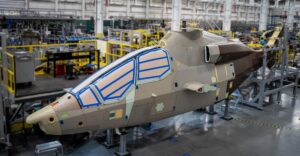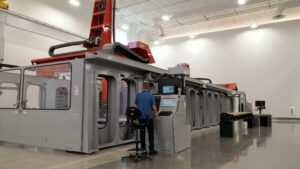AMARILLO & FORT WORTH, Texas — Bell’s [TXT] build of the 360 Invictus helicopter for the Army’s Future Attack Reconnaissance Aircraft (FARA) competitive prototyping effort is over 80 percent complete, while first flight has been pushed to early 2023 due to a delay in delivery of the General Electric Aviation
[GE]-built Improved Turbine Engine Program (ITEP) engine.
During a visit to Bell’s manufacturing facility in Amarillo, Texas where the 360 Invictus is being built, company officials told reporters the build structure of the helicopter minus the engine is expected to be completed around the May timeframe.

Chris Gehler, Bell’s vice president and program director for FARA, said the ITEP engine is set to go through “first engine to test” this month before being delivered for integration in late 2022.
GE Aviation was awarded a $517 million contract in February 2019 to develop its T901 engine for ITEP, which will be the future engine for FARA as well as the Army’s AH-64 Apache and UH-60 Black Hawk helicopters (Defense Daily, Feb. 1 2019)
For FARA, the Army has selected Bell’s 360 Invictus and Sikorsky’s [LMT] Raider X designs for a competitive prototyping (CP) phase as it looks to field a new scout attack helicopter.
Bell is also competing with V-280 Valor tiltrotor against a a Sikorsky-Boeing [BA] team’s Defiant X platform for the Army’s Future Long Range Assault Aircraft (FLRAA) program, with a production contract for the Black Hawk replacement program to be awarded later this fiscal year.
Culley Shafer, Bell’s manager for 360 Invictus assembly, noted to reporters that work on the 360 Invictus prototype began in October 2020 and is now in the stage for final assembly work with major components such as the forward fuselage and open tail rotor 100 percent completed.
Shafer said Bell has taken a “truly modular approach to manufacturing” for 360 Invictus at its Amarillo Assembly Center, where the company runs its V-22 and H-1 production lines, to include extensive use of model-based design work aimed at lowering future sustainment costs.
Gehler said the delay in first flight for the FARA CP phase will allow Bell more time for ground testing and a chance to consider potential design refinements for FARA Increment 1, which will be the platform selected around fiscal year 2024 for the initial program of record.
Looking ahead to potential production on both FARA and FLRAA, Bell has opened a new Manufacturing Technology Center (MTC) in Fort Worth, Texas to refine production processes with advanced machines and research and development projects aimed at finding ways to rapidly manufacture critical components and help reduce long-term sustainment costs.

“This place is really to help that transition into the production process. We have the capability to build one-off aircraft and that’s great. But the transition into production is where a lot of things fall in the creek, if you will,” Glenn Isbell, Bell’s vice president for rapid prototyping and manufacturing innovation, told reporters at the MTC. “The things we’re working on here are 3x, 4x, 5x better than what we’re doing in our current production lines today. We’re hitting the same quality metrics but we think we can do it quicker, faster and just take a different approach.”
Keith Flail, executive vice president for advanced vertical lift systems, said the company has invested about $50 million to date in the MTC, with plans to spend around $100 million on the facility as Bell looks to leverage digital engineering for a platform’s entire lifecycle.
“What we’re doing [at the MTC] is really determining everything that’s going to be in your future factory, so you look down the process, you lock down the recipe, you lock down the machines that you need and you can port that right to your factory. So that way you’re not trying to stand up a future factory and you’re still figuring out how you’re going to use the machines and the multipurpose aspects of it,” Flail said.
Isbell cited an example of a planetary carrier, a key helicopter component, that previously took 150 hours to manufacture for the Bell 525 platform that now takes 16 hours using capabilities out of the MTC.
“This is how we can do both FARA and FLRAA basically with almost exactly the same factory footprint, maybe with a couple different pieces added in there,” Isbell said. “We’re trying to get to military capability at commercial affordability.”
Terry Horner, a director of government relations with Bell, told Defense Daily during an interview last month he doesn’t see concerns with the Army’s ability to afford both FARA and FLRAA at the same time, in part due to the ability to lower sustainment costs with the emphasis on digital design and new manufacturing processes.
“We expect that the Army will move forward on [the FARA] program. There are rumblings inside of the Beltway about programs all the time, but there’s indications to us that the Army is walking away from that program. And we think the Army can afford both [FARA and FLRAA] based on their budgeting and based on their capability requirements in their documents,” Horner said. “Some say the Army can’t afford both [FARA and FLRAA]. With the approach that industry’s taking with information age manufacturing and digital design and then the ability to use modern manufacturing processes and then the [Modular Open Systems Architecture] will help the Army make both programs affordable.”